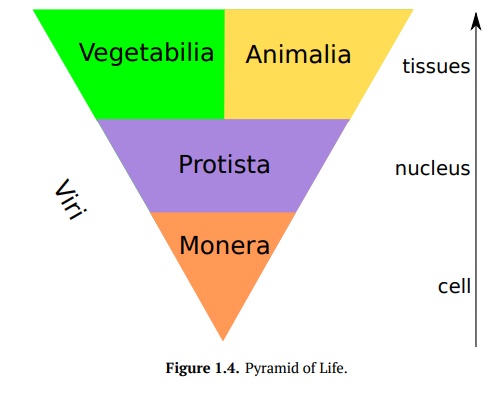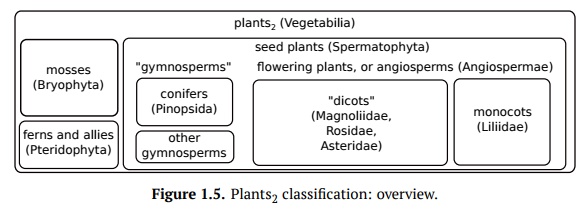Chapter: Introduction to Botany: Introduction
Taxonomy
Taxonomy
Taxonomy,
systematics and classification are
terms with similar meanings;they are all about the overwhelming diversity of
living organisms, for there are more than 2,000,000 species (and 300,000 of
them belong to plants2). Phyloge-netics
is a more fashionable term; it emphasizes the evolutionary history (phy-logeny) of taxonomic groups (taxa).
This taxonomic organization is hierarchical.
Most scientists accept seven main levels of taxonomy (ranks): the highest is kingdom,
followed by phylum, class, order, family, genus, and lastly, species.

The highest rank, kingdoms are easy to
understand as the pyramid of life
(Fig. 1.4) which is divided into four
levels—kingdoms. At the bottom is Monera,
which consists of prokaryotes (Bacteria and Archaea). This is the first level
of life: Mon-era have simplest cells without nucleus. The next level is Protista. These are eukaryotes (nuclear
cells) without tissues; some examples are algae and fungi. The final level
consists of two groups: Vegetabilia
and Animalia. They both have tissues
but have obtained them for completely different purposes. Animals have tissues to hunt and digest, while plants have
tissues mainly to survive onland.
Viri which are mentioned sideways, are not living things but merely piecesof
DNA or RNA which “went astray” out of cells of living organisms of all four
kingdoms. Despite of being non-living, viruses are capable of evolution.

Plants2 (kingdom Vegetabilia) contain
more than 300,000 species and divided in multiple subgroups (Fig. 1.5).

Ranks are used to compare taxonomic groups (taxa) from different major groups. No
precise definitions are available for particular ranks, but it is believed that
they are associated with the time of divergence (separation) between taxa. In
ad-dition to seven ranks mentioned above plant taxonomy uses intermediate ranks
like subfamily, subclass or superorder—when
taxonomic structure is too complicated.
Below is and example of names used for different
ranks. Please note that names used for some ranks have standardized endings
(underlined):
It is frequent when one species has several
geographical races without clear bor-ders between them. The example might be
the stinging nettle, Urtica dioica.
In North America, many nettles have narrower leaves and are less stinging than
in Eurasia. However, there are many intermediate forms between these races. To
reflect this, taxonomists introduced two subspecies:
in this case, Urtica diuica subsp. dioica (“Eurasian”) and U. dioica subsp. gracilis (“North American”). An-other frequently used under-species
category which is cultivar. Cultivars
arefrequently used in gardening. For example, many roses in cultivation belong
to different cultivars of Rosa banksiae,
and yellow roses are often Rosa banksiae
cv. ‘Lutea’ where the last part of name is for the cultivar.
Names of species are binomials which consist of the name of genus and speciesepithet:

If one does not know the exact species, “sp.”
shortcut is used instead of epithet, and “spp.” is used as a shortcut for
multiple unknown species. It is required to use slanted font when one prints a name of species or genus. All
scientific names are capitalized, but the second word in a species name
(species epithet) always starts from lower case letter. It is a well-known fact
that some species have a hybrid origin, and in these cases, botanists use a
multiplication sign ( ). For example, common plum (Prunus domestica) is a hybrid between blackthorn and cherry plum: Prunus spinosa Prunus cerasifera.
The group of plants or animals must have one and
only one name. Ideally, the name should be a stable ID for all occasions. But
since biology is a “science of exceptions”, some plant families are allowed to
bear two names. As an ex-ample, legumes (Leguminosae)
are frequently named “Fabaceae”, and grasses (Gramineae) have the second name “Poaceae”.
Throughout the long history of taxonomy, too
many names were given to the same taxa. At the moment, we have almost
20,000,000 names to describe 2,000,000 species. These 18,000,000 “excess names”
are synonyms which should not be
used in science. To regulate the use of names, nomenclature codes were cre-ated. These codes specify, for example,
the rule of priority: when two namesare given for the same group,
only earlier name is valid. Consequently, it is recom-mended to list the
author and the year of description along with a name: “Homosapiens L. 1758”, which means that founder of taxonomy, Carolus
Linnaeus (“L.”shortcut) described this species in 1758.
Another important concept of nomenclature is the
nomenclature type. Prac-tically,
this means that every species name must be associated with the phys-ical museum
specimen. In botany, these museums are collections of dried and pressed plants,
called herbaria. Type specimens are
of immense importance be-cause there are no labels in nature, and only these
specimens will “tell” about real plants or animals associated with particular
names.
Names of taxa higher than species also have
nomenclature types, but in these cases they are other names, not specimens.
This example may clarify the use on nomenclature types. Initially, oleaster
family (Elaeagnaceae) contained two genera, Elaeagnus
(oleaster) and Hippophaë
(sea-buckthorn). The second genus included Hippophaë
rhamnoides (Siberian sea-buckthorn, type
species) and Hip-pophaë canadensis (North
American plant). Thomas Nuttall decided to split sea-buckthorns in two genera.
Since one of them contains Hippophaë
rhamnoides, the type species, it
should keep the name Hippophaë. The
second genus can be named arbitrarily. Nuttall gave it name “Shepherdia”. As a result, the species
which had name Hippohaë canadensis
L., became Shepherdia canadensis (L.)
Nutt.
Plant taxonomy is a science. That means that our
understanding of plant groups will always change. It also means that there
always are different competing opinions, the taxonomic hypotheses which describe plant diversity in different
ways. As a result, some groups of plants could be accepted in a broad sense,
in-cluding as many subgroups as possible. For example, there might be an
opinion of Homo sapiens s.l. (sensu lato = wide sense) including not
only contemporary humans but also Neanderthal men. As a contrast, other
opinions may accept groups in a strict sense, and Homo sapiens s.str. (sensu
stricto = strict sense) in-cludes only contemporary humans.
Related Topics